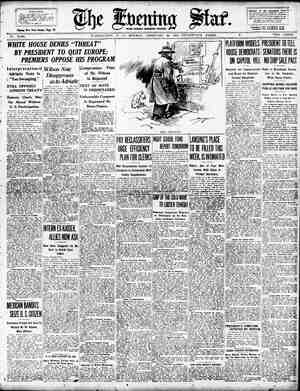New Britain Herald Newspaper, February 16, 1920, Page 10
You have reached the hourly page view limit. Unlock higher limit to our entire archive!
Subscribers enjoy higher page view limit, downloads, and exclusive features.
DEMAND A portion of the Electric Plant with 11 upkeep cost of Faxes, A Jmterest or 1nvestmesnt. manirenasice, ke a"w ng;ae ve YOU. The ‘demand” < , ‘,séea/;'ed Ypon the number of seuire feer in your fouse /s what you are asked 7o poy efc. /s held constantly CONSUMER Meter readers, brll clerks, cashrers, inspecrors, efc. musr beemployed by #he office fo Serve YOU whetther you vse arny corren# or mo#. 7k%e ‘consurmer "charge 15 o pay your paortion of rhis office ENERGY After having paid e demand * and ‘cornsumer charges, yov can €njoy the use of any armountt of energy or efectr/c curren¥ 7n yourfouse at about ore-falF ke ofd rafe per kilowar hour: s %4y ro youR " % mmonth for t/s service. ?;f/.'s/g ok, equitable charge. Fair to All-Favors None - Co-Operative Idea Gives to New Britain Fairest, Most Attractive Electric Rates Yet Devised v Co-operation is the big idea back of the new electric rates. Each consumer pays his just share, and, in being fair to his neighbor, he is also benefiting himself. In sound economics you can’t get something for nothing. The new electric rates are sound. After a trial of six weeks, they are pronounged fair and equitable— yes, and highly advantageous-—by those consumers who have learn- ed to know them. Under the rate formerly chargéd. if the consumer used no electricity he paid only 50 cents a- month. Beyond that minimun he paid only for the number of kilowatt hours used. But— . The cost of serving him—which amounted to more than 50 cents a month—went on whether h= used the service or not. So others, who used the service, had to pay for his convenience. That wasn't fair. Few persons would wish to t-ke such an advantage if they un- derstood. Right thinking people wish to pay their own way. After long, careful study of rate methods, we adopted the “Service-Charge’’ plan. We put it into effect in this territory Jan- ary 1, 1920. Most consumers too' to it readily. A considerable percentage found that they would pav less than before—when they ‘were helping to carry the non-proStable consumers. Some few ob- jected to the rate. A few still thin': the old way was better. For the benefit of those who are still in doubt about the advantages of the new plan, we wi'l again explain its features. The present electric rate is what is sometimes called a “three- way’’ rate. That is because it contains three provisions—a ‘‘Con- sumer’’ Charge, a “Demand’ Cha-ge, and an “Enetgy” Charge. Consumer Charge—For each consumer on its books the Com- : pany must spend a certain amoun* each month. It must send a me- ter reader to his house or place of business. It must at times send an inspector. It must have a bill clerk go over the records and make up his bill. It must use stationerv and postage for his account. It must have a cashier ready to receive and enter his payment. These expenses go on whether the consumer uses any electricity or not. Un- der the new plan each consumer pays 50 cents a month for this service. Demand Charge—This charge refers to the Electric Plant ser- vice, while the Consumer charge refers to Office service. We make this a separate charge in justice to our consumers, hecause, while it costs about the same amount to c2rry one consumer as another from the office standpoint, the cost varie- from the plant standpoint accord- ing to the size of each consumer’s house or building. There are at the plant such expenses as taxes, interest on money invested, main- tenance, etc. Facilities must be maintained to licht one’s whole house, or furnish electricity for oth#r purnoses, if called upon. So we make a charge of 4 cents per 100 sgjuare feet of floor space per month for this ““demand.” Energy Charge—This is a straight charge of 5 cents per kilo- watt hour for current after the Consumer Charge and Demand Charge have been taken care of. = Under this method there is no favored class of consumers to be carried by another class. Those who really wish to take advantage of modern electric service can now do so at a rate which is unusually low after the service charges have been met. To KNOW the “Service-Charge” Plan is to APPROVE Ii The Connecticut Light & Power Company








